Aleksandar Radić; Sam M. Lambrick; Nick A. von Jeinsen; Andrew P. Jardine; David J. Ward
3D surface profilometry using neutral helium atoms Journal Article
In: Applied Physics Letters, vol. 124, pp. 203101, 2024.
@article{nokey,
title = { 3D surface profilometry using neutral helium atoms},
author = {Aleksandar Radić and Sam M. Lambrick and Nick A. von Jeinsen and Andrew P. Jardine and David J. Ward},
url = { https://doi.org/10.1063/5.0206374},
doi = {10.1063/5.0206374},
year = {2024},
date = {2024-05-14},
journal = {Applied Physics Letters},
volume = {124},
pages = {203101},
keywords = {},
pubstate = {published},
tppubtype = {article}
}
Boyao Liu; William Allison; Bo Peng; Nadav Avidor; Bartomeu Monserrat; Andrew P. Jardine
Distinguishing Quasiparticle-Phonon Interactions by Ultrahigh-Resolution Lifetime Measurements Journal Article
In: Physics Review Letters, vol. 132, pp. 176202 , 2024.
@article{nokey,
title = {Distinguishing Quasiparticle-Phonon Interactions by Ultrahigh-Resolution Lifetime Measurements},
author = {Boyao Liu and William Allison and Bo Peng and Nadav Avidor and Bartomeu Monserrat and Andrew P. Jardine},
url = {https://journals.aps.org/prl/abstract/10.1103/PhysRevLett.132.176202},
doi = {10.1103/PhysRevLett.132.176202},
year = {2024},
date = {2024-04-24},
urldate = {2024-04-24},
journal = {Physics Review Letters},
volume = {132},
pages = {176202 },
keywords = {},
pubstate = {published},
tppubtype = {article}
}
Agata Sabik; John Ellis; Holly Hedgeland; David J. Ward; Andrew P. Jardine; William Allison; Grażyna Antczak; Anton Tamtögl
Single-molecular diffusivity and long jumps of large organic molecules: CoPc on Ag(100) Journal Article
In: Frontiers in Chemistry, vol. 12, 2024, ISSN: 2296-2646.
@article{nokey,
title = {Single-molecular diffusivity and long jumps of large organic molecules: CoPc on Ag(100)},
author = {Agata Sabik and John Ellis and Holly Hedgeland and David J. Ward and Andrew P. Jardine and William Allison and Grażyna Antczak and Anton Tamtögl},
url = {https://www.frontiersin.org/articles/10.3389/fchem.2024.1355350 },
doi = {10.3389/fchem.2024.1355350},
issn = {2296-2646},
year = {2024},
date = {2024-02-06},
journal = {Frontiers in Chemistry},
volume = {12},
abstract = {Energy dissipation and the transfer rate of adsorbed molecules do not only determine the rates of chemical reactions but are also a key factor that often dictates the growth of organic thin films. Here, we present a study of the surface dynamical motion of cobalt phthalocyanine (CoPc) on Ag(100) in reciprocal space based on the helium spin-echo technique in comparison with previous scanning tunnelling microscopy studies. It is found that the activation energy for lateral diffusion changes from 150 meV at 45–50 K to ≈100 meV at 250–350 K, and that the process goes from exclusively single jumps at low temperatures to predominantly long jumps at high temperatures. We thus illustrate that while the general diffusion mechanism remains similar, upon comparing the diffusion process over widely divergent time scales, indeed different jump distributions and a decrease of the effective diffusion barrier are found. Hence a precise molecular-level understanding of dynamical processes and thin film formation requires following the dynamics over the entire temperature scale relevant to the process. Furthermore, we determine the diffusion coefficient and the atomic-scale friction of CoPc and establish that the molecular motion on Ag(100) corresponds to a low friction scenario as a consequence of the additional molecular degrees of freedom.},
keywords = {},
pubstate = {published},
tppubtype = {article}
}
Boyao Liu; Jack Kelsall; David J. Ward; Andrew P. Jardine
Experimental Characterization of Defect-Induced Phonon Lifetime Shortening Journal Article
In: Physics Review Letters, vol. 132, iss. 5, no. 056202 , 2024.
@article{nokey,
title = {Experimental Characterization of Defect-Induced Phonon Lifetime Shortening},
author = {Boyao Liu and Jack Kelsall and David J. Ward and Andrew P. Jardine},
url = {https://doi.org/10.1103/PhysRevLett.132.056202},
doi = {10.1103/PhysRevLett.132.056202},
year = {2024},
date = {2024-02-02},
journal = {Physics Review Letters},
volume = {132},
number = {056202 },
issue = {5},
abstract = {We present the first direct experimental measurement of defect-induced lifetime shortening of acoustic surface phonons. Defects are found to contribute a temperature-independent component to the linewidths of Rayleigh wave phonons on a Ni(111) surface. We also characterized the increase in phonon scattering with both surface defect density and phonon wave vector. A quantitative estimate of the scattering rate between phonon modes and surface line defects is extracted from the experimental data for the first time.},
keywords = {},
pubstate = {published},
tppubtype = {article}
}
NA von Jeinsen; SM Lambrick; M Bergin; A Radić; B Liu; D Seremet; AP Jardine; DJ Ward
2D helium atom diffraction from a microscopic spot Journal Article
In: Physical Review Letters, vol. 131, iss. 23, no. 236202, 2023.
@article{nokey,
title = {2D helium atom diffraction from a microscopic spot},
author = {NA von Jeinsen and SM Lambrick and M Bergin and A Radić and B Liu and D Seremet and AP Jardine and DJ Ward},
url = {https://journals.aps.org/prl/abstract/10.1103/PhysRevLett.131.236202},
doi = {10.1103/PhysRevLett.131.236202},
year = {2023},
date = {2023-12-06},
urldate = {2023-09-20},
journal = {Physical Review Letters},
volume = {131},
number = {236202},
issue = {23},
abstract = {A method for measuring helium atom diffraction with micron-scale spatial resolution is demonstrated in a scanning helium microscope (SHeM) and applied to study a micron-scale spot on the (100) plane of a lithium fluoride (LiF) crystal. The positions of the observed diffraction peaks provide an accurate measurement of the local lattice spacing, while a combination of close-coupled scattering calculations and Monte-Carlo ray-tracing simulations reproduce the main variations in diffracted intensity. Subsequently, the diffraction results are used to enhance image contrast by measuring at different points in reciprocal space. The results open up the possibility for using helium micro-diffraction to characterize the morphology of delicate or electron-sensitive materials on small scales. These include many fundamentally and technologically important samples which cannot be studied in conventional atom scattering instruments, such as small grain size exfoliated 2D materials, polycrystalline samples, and other surfaces that do not exhibit long-range order.},
keywords = {},
pubstate = {published},
tppubtype = {article}
}
Luke Staszewski; Nadav Avidor
Blue shifts in helium-surface bound-state resonances and quantum effects in cosine-law scattering Journal Article
In: Physical Chemistry Chemical Physics, vol. 25, iss. 47, pp. 32632-32636, 2023.
@article{nokey,
title = { Blue shifts in helium-surface bound-state resonances and quantum effects in cosine-law scattering },
author = {Luke Staszewski and Nadav Avidor},
doi = {10.1039/D3CP02291A},
year = {2023},
date = {2023-11-15},
journal = {Physical Chemistry Chemical Physics},
volume = {25},
issue = {47},
pages = {32632-32636},
abstract = {
The scattering of gas from surfaces underpins technologies in fields such as gas permeation, heterogeneous catalysis and chemical vapour deposition. The effect of surface defects on the scattering is key in such technologies, but is still poorly understood. It is known empirically that unordered surfaces result-in random-angle scattering, with the effect thought to be classical. We here demonstrate the transition from quantum mechanical diffraction to cosine-scattering, and show that quantum bound-state resonances can greatly affect this transition. Further, we find that randomly distributed defects induce a blue-shift in the bound-state energies. We explore this phenomena, which can lay the basis for helium based quantum metrology of defects in 2D materials and material surfaces.},
keywords = {},
pubstate = {published},
tppubtype = {article}
}
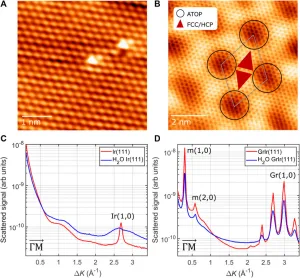
S Kyrkjebø; A Cassidy; SM Lambrick; AP Jardine; B Holst; L Hornekær
3He spin-echo scattering indicates hindered diffusion of isolated water molecules on graphene-covered Ir(111) Journal Article
In: Front. Chem. , vol. 11, 2023, ISSN: 2296-2646.
@article{nokey,
title = {3He spin-echo scattering indicates hindered diffusion of isolated water molecules on graphene-covered Ir(111)},
author = {S Kyrkjebø and A Cassidy and SM Lambrick and AP Jardine and B Holst and L Hornekær},
editor = {Marco Sacchi},
url = {https://www.frontiersin.org/articles/10.3389/fchem.2023.1229546/full?&utm_source=Email_to_authors_&utm_medium=Email&utm_content=T1_11.5e1_author&utm_campaign=Email_publication&field=&journalName=Frontiers_in_Chemistry&id=1229546},
doi = {10.3389/fchem.2023.1229546},
issn = {2296-2646},
year = {2023},
date = {2023-10-06},
urldate = {2023-10-06},
journal = {Front. Chem. },
volume = {11},
abstract = {The dynamics of water diffusion on carbon surfaces are of interest in fields as diverse as furthering the use of graphene as an industrial-coating technology and understanding the catalytic role of carbon-based dust grains in the interstellar medium. The early stages of water–ice growth and the mobility of water adsorbates are inherently dependent on the microscopic mechanisms that facilitate water diffusion. Here, we use 3He spin-echo quasi-inelastic scattering to probe the microscopic mechanisms responsible for the diffusion of isolated water molecules on graphene-covered and bare Ir(111). The scattering of He atoms provides a non-invasive and highly surface-sensitive means to measure the rate at which absorbates move around on a substrate at very low coverage. Our results provide an approximate upper limit on the diffusion coefficient for water molecules on GrIr(111) of <10−12 m2/s, an order of magnitude lower than the coefficient that describes the diffusion of water molecules on the bare Ir(111) surface. We attribute the hindered diffusion of water molecules on the GrIr(111) surface to water trapping at specific areas of the corrugated moiré superstructure. Lower mobility of water molecules on a surface is expected to lead to a lower ice nucleation rate and may enhance the macroscopic anti-icing properties of a surface.},
keywords = {},
pubstate = {published},
tppubtype = {article}
}
EE Torres-Miyares; DJ Wardand G Rojas-Lorenzoand J Rubayo-Soneira; W Allison; S Miret-Artés
The stochastic wave function method for diffusion of alkali atoms on metallic surfaces Bachelor Thesis
2023.
@bachelorthesis{nokey,
title = { The stochastic wave function method for diffusion of alkali atoms on metallic surfaces },
author = { EE Torres-Miyares and DJ Wardand G Rojas-Lorenzoand J Rubayo-Soneira and W Allison and S Miret-Artés},
url = {https://doi.org/10.1039/D2CP05511B },
doi = {10.1039/D2CP05511B },
year = {2023},
date = {2023-02-03},
journal = {Physical Chemistry Chemical Physics},
volume = {25},
issue = {8},
pages = {6225-6231},
abstract = {
The stochastic wave function method is proposed to study the diffusion regimes of alkali atoms on metallic surfaces. The Lindblad approach, based on the microscopic Hamiltonian information in the Caldeira–Leggett model, is presented and numerical calculations of the dynamics are carried out to characterize surface diffusion for two different systems: Na–Cu(111) and Li–Cu(111). Calculations of the intermediate scattering function for an isolated adsorbate are compared, in the Brownian limit, with results deduced from helium spin-echo (HeSE) experiments after reducing them to single adsorbate dynamics. To illustrate the method we present the dependence on momentum transfer and the temperature dependency. Results show that the experiment can be described at a quantitative level by the 1-D quantum model (reduced dimensionality).
},
keywords = {},
pubstate = {published},
tppubtype = {bachelorthesis}
}
Marco Sacchi; Anton Tamtögl
Water adsorption and dynamics on graphene and other 2D materials: computational and experimental advances Journal Article
In: Advances in Physics: X, vol. 8, iss. 1, 2022.
@article{nokey,
title = {Water adsorption and dynamics on graphene and other 2D materials: computational and experimental advances},
author = {Marco Sacchi and Anton Tamtögl},
url = {https://doi.org/10.1080/23746149.2022.2134051},
doi = {10.1080/23746149.2022.2134051},
year = {2022},
date = {2022-11-11},
journal = {Advances in Physics: X},
volume = {8},
issue = {1},
abstract = {The interaction of water and surfaces, at molecular level, is of critical importance for understanding processes such as corrosion, friction, catalysis and mass transport. The significant literature on interactions with single crystal metal surfaces should not obscure unknowns in the unique behaviour of ice and the complex relationships between adsorption, diffusion and long-range inter-molecular interactions. Even less is known about the atomic-scale behaviour of water on novel, non-metallic interfaces, in particular on graphene and other 2D materials. In this manuscript, we review recent progress in the characterisation of water adsorption on 2D materials, with a focus on the nano-material graphene and graphitic nanostructures; materials which are of paramount importance for separation technologies, electrochemistry and catalysis, to name a few. The adsorption of water on graphene has also become one of the benchmark systems for modern computational methods, in particular dispersion-corrected density functional theory (DFT). We then review recent experimental and theoretical advances in studying the single-molecular motion of water at surfaces, with a special emphasis on scattering approaches as they allow an unparalleled window of observation to water surface motion, including diffusion, vibration and self-assembly.},
keywords = {},
pubstate = {published},
tppubtype = {article}
}
A Ruckhofer; M Sacchi; A Payne; AP Jardine; WE Ernst; N Avidor; A Tamtögl
Evolution of ordered nanoporous phases during h-BN growth: controlling the route from gas-phase precursor to 2D material by in situ monitoring Journal Article
In: NanoScience Horizons, 2022.
@article{Ruckhofer2022,
title = {Evolution of ordered nanoporous phases during h-BN growth: controlling the route from gas-phase precursor to 2D material by in situ monitoring},
author = {A Ruckhofer and M Sacchi and A Payne and AP Jardine and WE Ernst and N Avidor and A Tamtögl},
url = {DOI
https://doi.org/10.1039/D2NH00353H },
doi = {10.1039/D2NH00353H},
year = {2022},
date = {2022-09-21},
urldate = {2022-09-21},
journal = {NanoScience Horizons},
abstract = {Large-area single-crystal monolayers of two-dimensional (2D) materials such as graphene and hexagonal boron nitride (h-BN) can be grown by chemical vapour deposition (CVD). However, the high temperatures and fast timescales at which the conversion from a gas-phase precursor to the 2D material appears, make it extremely challenging to simultaneously follow the atomic arrangements. We utilise helium atom scattering to discover and control the growth of novel 2D h-BN nanoporous phases during the CVD process. We find that prior to the formation of h-BN from the gas-phase precursor, a metastable (3 × 3) structure is formed, and that excess deposition on the resulting 2D h-BN leads to the emergence of a (3 × 4) structure. We illustrate that these nanoporous structures are produced by partial dehydrogenation and polymerisation of the borazine precursor upon adsorption. These steps are largely unexplored during the synthesis of 2D materials and we unveil the rich phases during CVD growth. Our results provide significant foundations for 2D materials engineering in CVD, by adjusting or carefully controlling the growth conditions and thus exploiting these intermediate structures for the synthesis of covalent self-assembled 2D networks.},
keywords = {},
pubstate = {published},
tppubtype = {article}
}

SM Lambrick; M Bergin; DJ Ward; M Barr; A Fahy; T Myles; A Radić; PC Dastoor; J Ellis; AP Jardine
Observation of diffuse scattering in scanning helium microscopy Journal Article
In: Phys. Chem. Chem. Phys, vol. 24, pp. 26539-26546, 2022.
@article{nokey,
title = {Observation of diffuse scattering in scanning helium microscopy},
author = {SM Lambrick and M Bergin and DJ Ward and M Barr and A Fahy and T Myles and A Radić and PC Dastoor and J Ellis and AP Jardine},
url = {https://doi.org/10.1039/D2CP01951E},
doi = {10.1039/D2CP01951E},
year = {2022},
date = {2022-09-20},
urldate = {2022-09-20},
journal = {Phys. Chem. Chem. Phys},
volume = {24},
pages = {26539-26546},
abstract = {In understanding the nature of contrast in the emerging field of neutral helium microscopy, it is important to identify if there is an atom–surface scattering distribution that can be expected to apply broadly across a range of sample surfaces. Here we present results acquired in a scanning helium microscope (SHeM) under typical operating conditions, from a range of surfaces in their native state, i.e. without any specialist sample preparation. We observe diffuse scattering, with an approximately cosine distribution centred about the surface normal. The ‘cosine-like’ distribution is markedly different from those distributions observed from the well-prepared, atomically pristine, surfaces typically studied in helium atom scattering experiments. Knowledge of the typical scattering distribution in SHeM experiments provides a starting basis for interpretation of topographic contrast in images, as well as a reference against which more exotic contrast mechanisms can be compared.},
keywords = {},
pubstate = {published},
tppubtype = {article}
}
W Allison; S Miret-Artés; E Pollak
Perturbation theory of scattering for grazing-incidence fast-atom diffraction Journal Article
In: Phys. Chem. Chem. Phys., 2022.
@article{Allison2022,
title = {Perturbation theory of scattering for grazing-incidence fast-atom diffraction},
author = { W Allison and S Miret-Artés and E Pollak},
url = {https://doi.org/10.1039/D2CP01013E },
year = {2022},
date = {2022-06-17},
urldate = {2022-06-17},
journal = {Phys. Chem. Chem. Phys.},
publisher = {The Royal Society of Chemistry},
abstract = {Recent grazing-incidence, fast atom diffraction (GIFAD) experiments have highlighted the well known observation that the distance between classical rainbow angles depends on the incident energy. The GIFAD experiments imply an incident vertical scattering angle, facilitating an analytic analysis using classical perturbation theory, which leads to the conclusion that the so called “dynamic corrugation” amplitude, as defined by Bocan et al., Phys. Rev. Lett., 2020 125, 096101 is, within first-order perturbation theory, proportional to the tangent of the rainbow angle. Therefore it provides no further information about the interaction than is gleaned from the rainbow angle and its energy dependence. Perhaps more importantly, the resulting analytic theory reveals how the energy dependence of rainbow angles may be inverted into information on the force field governing the interaction of the incident projectile with the surface.},
keywords = {},
pubstate = {published},
tppubtype = {article}
}
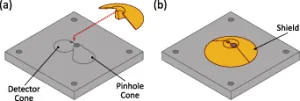
M Bergin; TA Myles; A Radic; CJ Hatchwell; SM Lambrick; DJ Ward; SD Eder; AFahy; M Barr; PC Dastoor
Complex optical elements for scanning helium microscopy through 3D printing Journal Article
In: Journal of Physics D: Applied Physics, vol. 55, no. 9, pp. 095305, 2022.
@article{complexelements,
title = {Complex optical elements for scanning helium microscopy through 3D printing},
author = {M Bergin and TA Myles and A Radic and CJ Hatchwell and SM Lambrick and DJ Ward and SD Eder and AFahy and M Barr and PC Dastoor},
url = {https://doi.org/10.1088/1361-6463/ac3a3e
https://doi.org/10.5281/zenodo.5496454},
doi = {10.1088/1361-6463/ac3a3e},
year = {2022},
date = {2022-03-03},
urldate = {2022-03-03},
journal = {Journal of Physics D: Applied Physics},
volume = {55},
number = {9},
pages = {095305},
abstract = {Developing the next generation of scanning helium microscopes requires the fabrication of optical elements with complex internal geometries. We show that resin stereolithography (SLA) 3D printing produces low-cost components with the requisite convoluted structures whilst achieving the required vacuum properties, even without in situ baking. As a case study, a redesigned pinhole plate optical element of an existing scanning helium microscope was fabricated using SLA 3D printing. In comparison to the original machined component, the new optical element minimised the key sources of background signal, in particular multiple scattering and the secondary effusive beam.},
keywords = {},
pubstate = {published},
tppubtype = {article}
}
N Avidor
Probing surface motion above ambient temperature with helium spin-echo spectroscopy Journal Article
In: Nature Reviews Physics, 2021.
@article{Avidor2021,
title = {Probing surface motion above ambient temperature with helium spin-echo spectroscopy},
author = {N Avidor},
url = {https://www.nature.com/articles/s42254-021-00387-2},
doi = {10.1038/s42254-021-00387-2},
year = {2021},
date = {2021-10-12},
urldate = {2021-10-12},
journal = {Nature Reviews Physics},
keywords = {},
pubstate = {published},
tppubtype = {article}
}
M Bergin; DJ Ward; SM Lambrick; NA von Jeinsen; B Holst; J Ellis; AP Jardine; W Allison
Low-energy electron ionization mass spectrometer for efficient detection of low mass species Journal Article
In: Review of Scientific Instruments, vol. 92, iss. 7, pp. 073305, 2021, ISSN: 0034-6748.
@article{nokey,
title = {Low-energy electron ionization mass spectrometer for efficient detection of low mass species},
author = {M Bergin and DJ Ward and SM Lambrick and NA von Jeinsen and B Holst and J Ellis and AP Jardine and W Allison},
url = {https://doi.org/10.1063/5.0050292},
doi = {10.1063/5.0050292},
issn = {0034-6748},
year = {2021},
date = {2021-07-20},
journal = {Review of Scientific Instruments},
volume = {92},
issue = {7},
pages = {073305},
abstract = {The design of a high-efficiency mass spectrometer is described, aimed at residual gas detection of low mass species using low-energy electron impact, with particular applications in helium atom microscopy and atomic or molecular scattering. The instrument consists of an extended ionization volume, where electrons emitted from a hot filament are confined using a solenoidal magnetic field to give a high ionization probability. Electron space charge is used to confine and extract the gas ions formed, which are then passed through a magnetic sector mass filter before reaching an ion counter. The design and implementation of each of the major components are described in turn, followed by the overall performance of the detector in terms of mass separation, detection efficiency, time response, and background count rates. The linearity of response with emission current and magnetic field is discussed. The detection efficiency for helium is very high, reaching as much as 0.5%, with a time constant of (198 ± 6) ms and a background signal equivalent to an incoming helium flux of (8.7 ± 0.2) × 106 s−1.},
keywords = {},
pubstate = {published},
tppubtype = {article}
}
A Tamtögl; E Bahn; M Sacchi; J Zhu; DJ Ward; AP Jardine; SJ Jenkins; P Fouquet; J Ellis; W Allison
Motion of water monomers reveals a kinetic barrier to ice nucleation on graphene Journal Article
In: Nature Communications, vol. 12, pp. 3120, 2021.
@article{Tamtögl2021,
title = {Motion of water monomers reveals a kinetic barrier to ice nucleation on graphene},
author = {A Tamtögl and E Bahn and M Sacchi and J Zhu and DJ Ward and AP Jardine and SJ Jenkins and P Fouquet and J Ellis and W Allison},
url = {https://www.nature.com/articles/s41467-021-23226-5},
doi = {10.1038/s41467-021-23226-5},
year = {2021},
date = {2021-05-25},
urldate = {2021-05-25},
journal = {Nature Communications},
volume = {12},
pages = {3120},
abstract = {The interfacial behaviour of water remains a central question to fields as diverse as protein folding, friction and ice formation. While the properties of water at interfaces differ from those in the bulk, major gaps in our knowledge limit our understanding at the molecular level. Information concerning the microscopic motion of water comes mostly from computation and, on an atomic scale, is largely unexplored by experiment. Here, we provide a detailed insight into the behaviour of water monomers on a graphene surface. The motion displays remarkably strong signatures of cooperative behaviour due to repulsive forces between the monomers, enhancing the monomer lifetime ( ≈ 3 s at 125 K) in a free-gas phase that precedes the nucleation of ice islands and, in turn, provides the opportunity for our experiments to be performed. Our results give a molecular perspective on a kinetic barrier to ice nucleation, providing routes to understand and control the processes involved in
ice formation.
},
keywords = {},
pubstate = {published},
tppubtype = {article}
}
SM Lambrick; A Salvador Palau; Poul Erik Hansen; G Bracco; J Ellis; AP Jardine; B Holst
True-to-size surface mapping with neutral helium atoms Journal Article
In: Physical Review A, vol. 103, pp. 053315, 2021.
@article{Lambrick2021,
title = {True-to-size surface mapping with neutral helium atoms},
author = {SM Lambrick and A Salvador Palau and Poul Erik Hansen and G Bracco and J Ellis and AP Jardine and B Holst},
url = {https://journals.aps.org/pra/abstract/10.1103/PhysRevA.103.053315},
doi = {10.1103/PhysRevA.103.053315},
year = {2021},
date = {2021-05-19},
urldate = {2021-05-19},
journal = {Physical Review A},
volume = {103},
pages = {053315},
abstract = {Three-dimensional mapping of microscopic surface structures is important in many applications of technology and research, including areas as diverse as microfluidics, MEMS, and geoscience. However, on the nanoscale, using established techniques for such imaging can be extremely challenging. Scanning helium microscopy is a technique that uses neutral helium atoms as a probe, enabling completely nondestructive imaging. The technique is broadly applicable and ideal for many otherwise difficult-to-image materials, such as insulators, ultrathin nanocoatings, and biological samples. Here we present a method for implementation and operation of a stereo helium microscope, by applying the photometric stereo method of surface reconstruction to helium microscopy. Four detectors around the sample are typically required, but we show how sample rotation can be used to perform stereo reconstruction with a single-detector instrument, or to improve the quality of the reconstructed surface by increasing the number of independent measurements. We examine the quality of the reconstructed surface and
show that for low aspect ratio good absolute height is recovered. For features with height/width ∼1 the shape of the surface is still recovered well (8% error) despite multiple scattering and masking of the helium beam by surface topography. Therefore, it is possible to perform accurate reconstruction of the shape of nanoscale structures with a height to width ratio of at least unity.
},
keywords = {},
pubstate = {published},
tppubtype = {article}
}
J Kelsall; PSM Townsend; J Ellis; AP Jardine; N Avidor
Ultrafast Diffusion at the Onset of Growth: O/Ru(0001) Journal Article
In: Physical Review Letter, vol. 126, pp. 155901, 2021.
@article{Kelsall2021,
title = {Ultrafast Diffusion at the Onset of Growth: O/Ru(0001)},
author = {J Kelsall and PSM Townsend and J Ellis and AP Jardine and N Avidor},
url = {https://journals.aps.org/prl/abstract/10.1103/PhysRevLett.126.155901},
doi = {10.1103/PhysRevLett.126.155901},
year = {2021},
date = {2021-04-12},
urldate = {2021-04-12},
journal = {Physical Review Letter},
volume = {126},
pages = {155901},
abstract = {Nanoscopic clustering in a 2D disordered phase is observed for oxygen on Ru(0001) at low coverages
and high temperatures. We study the coexistence of quasistatic clusters (with a characteristic length of
∼9 Å) and highly mobile atomic oxygen which diffuses between the energy-inequivalent, threefold hollow
sites of the substrate. We determine a surprisingly low activation energy for diffusion of 385 +/- 20 meV.
The minimum of the O − O interadsorbate potential appears to be at lower separations than previously
reported.},
keywords = {},
pubstate = {published},
tppubtype = {article}
}
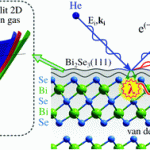
B Holst; G Alexandrowicz; N Avidor; G Benedek; G Bracco; WE Ernst; D Far’ias; AP Jardine; K Lefmann; JR Manson; others
In: Physical Chemistry Chemical Physics, 2021.
@article{holst2021material,
title = {Material Properties Particularly Suited to be Measured with Helium Scattering: Selected Examples from 2D Materials, van der Waals Heterostructures, Glassy Materials, Catalytic Substrates, Topological Insulators and Superconducting Radio Frequency Materials},
author = {B Holst and G Alexandrowicz and N Avidor and G Benedek and G Bracco and WE Ernst and D Far'ias and AP Jardine and K Lefmann and JR Manson and others},
doi = {https://doi.org/10.1039/D0CP05833E},
year = {2021},
date = {2021-01-01},
urldate = {2021-01-01},
journal = {Physical Chemistry Chemical Physics},
publisher = {Royal Society of Chemistry},
abstract = {Helium Atom Scattering (HAS) and Helium Spin-Echo scattering (HeSE), together helium scattering, are well established, but non-commercial surface science techniques. They are characterised by the beam inertness and very low beam energy (<0.1 eV) which allows essentially all materials and adsorbates, including fragile and/or insulating materials and light adsorbates such as hydrogen to be investigated on the atomic scale. At present there only exist an estimated less than 15 helium and helium spin-echo scattering instruments in total, spread across the world. This means that up till now the techniques have not been readily available for a broad scientific community. Efforts are ongoing to change this by establishing a central helium scattering facility, possibly in connection with a neutron or synchrotron facility. In this context it is important to clarify what information can be obtained from helium scattering that cannot be obtained with other surface science techniques. Here we present a non-exclusive overview of a range of material properties particularly suited to be measured with helium scattering: (i) high precision, direct measurements of bending rigidity and substrate coupling strength of a range of 2D materials and van der Waals heterostructures as a function of temperature, (ii) direct measurements of the electron–phonon coupling constant λ exclusively in the low energy range (<0.1 eV, tuneable) for 2D materials and van der Waals heterostructures (iii) direct measurements of the surface boson peak in glassy materials, (iv) aspects of polymer chain surface dynamics under nano-confinement (v) certain aspects of nanoscale surface topography, (vi) central properties of surface dynamics and surface diffusion of adsorbates (HeSE) and (vii) two specific science case examples – topological insulators and superconducting radio frequency materials, illustrating how combined HAS and HeSE are necessary to understand the properties of quantum materials. The paper finishes with (viii) examples of molecular surface scattering experiments and other atom surface scattering experiments which can be performed using HAS and HeSE instruments.},
keywords = {},
pubstate = {published},
tppubtype = {article}
}
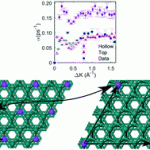
A Raghavan; L Slocombe; A Spreinat; DJ Ward; W Allison; J Ellis; AP Jardine; M Sacchi; N Avidor
Alkali metal adsorption on metal surfaces: new insights from new tools Journal Article
In: Physical Chemistry Chemical Physics, 2021.
@article{raghavan2021alkali,
title = {Alkali metal adsorption on metal surfaces: new insights from new tools},
author = {A Raghavan and L Slocombe and A Spreinat and DJ Ward and W Allison and J Ellis and AP Jardine and M Sacchi and N Avidor},
doi = {https://doi.org/10.1039/D0CP05365A},
year = {2021},
date = {2021-01-01},
urldate = {2021-01-01},
journal = {Physical Chemistry Chemical Physics},
publisher = {Royal Society of Chemistry},
abstract = {The adsorption of sodium on Ru(0001) is studied using 3He spin-echo spectroscopy (HeSE), molecular dynamics simulations (MD) and density functional theory (DFT). In the multi-layer regime, an analysis of helium reflectivity, gives an electron–phonon coupling constant of λ = 0.64 ± 0.06. At sub-monolayer coverage, DFT calculations show that the preferred adsorption site changes from hollow site to top site as the supercell increases and the effective coverage, θ, is reduced from 0.25 to 0.0625 adsorbates per substrate atom. Energy barriers and adsorption geometries taken from DFT are used in molecular dynamics calculations to generate simulated data sets for comparison with measurements. We introduce a new Bayesian method of analysis that compares measurement and model directly, without assuming analytic lineshapes. The value of adsorbate–substrate energy exchange rate (friction) in the MD simulation is the sole variable parameter. Experimental data at a coverage θ = 0.028 compares well with the low-coverage DFT result, giving an effective activation barrier Eeff = 46 ± 4 meV with a friction γ = 0.3 ps−1. Better fits to the data can be achieved by including additional variable parameters, but in all cases, the mechanism of diffusion is predominantly on a Bravais lattice, suggesting a single adsorption site in the unit cell, despite the close packed geometry.},
keywords = {},
pubstate = {published},
tppubtype = {article}
}
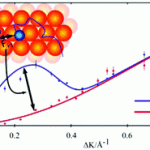
DJ Ward; A Raghavan; A Tamtögl; AP Jardine; E Bahn; J Ellis; S Miret-Art`es; W Allison
Inter-adsorbate forces and coherent scattering in helium spin-echo experiments Journal Article
In: Physical Chemistry Chemical Physics, 2021.
@article{ward2021inter,
title = {Inter-adsorbate forces and coherent scattering in helium spin-echo experiments},
author = {DJ Ward and A Raghavan and A Tamtögl and AP Jardine and E Bahn and J Ellis and S Miret-Art{`e}s and W Allison},
doi = {https://doi.org/10.1039/D0CP04539J},
year = {2021},
date = {2021-01-01},
urldate = {2021-01-01},
journal = {Physical Chemistry Chemical Physics},
publisher = {Royal Society of Chemistry},
abstract = {
In studies of dynamical systems, helium atoms scatter coherently from an ensemble of adsorbates as they diffuse on the surface. The results give information on the co-operative behaviour of interacting adsorbates and thus include the effects of both adsorbate–substrate and adsorbate–adsorbate interactions. Here, we discuss a method to disentangle the effects of interactions between adsorbates from those with the substrate. The result gives an approximation to observations that would be obtained if the scattering was incoherent. Information from the experiment can therefore be used to distinguish more clearly between long-range inter-adsorbate forces and the short range effects arising from the local lattice potential and associated thermal excitations. The method is discussed in the context of a system with strong inter-adsorbate interactions, sodium atoms diffusing on a copper (111) surface.},
keywords = {},
pubstate = {published},
tppubtype = {article}
}
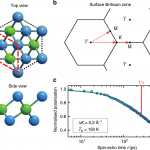
A Tamtögl; M Sacchi; N Avidor; I Calvo-Almazán; PSM Townsend; M Bremholm; P Hofmann; J Ellis; W Allison
Nanoscopic diffusion of water on a topological insulator Journal Article
In: Nature communications, vol. 11, no. 1, pp. 1–9, 2020.
@article{tamtogl2020nanoscopic,
title = {Nanoscopic diffusion of water on a topological insulator},
author = {A Tamtögl and M Sacchi and N Avidor and I Calvo-Almazán and PSM Townsend and M Bremholm and P Hofmann and J Ellis and W Allison},
doi = {https://doi.org/10.1038/s41467-019-14064-7},
year = {2020},
date = {2020-01-01},
urldate = {2020-01-01},
journal = {Nature communications},
volume = {11},
number = {1},
pages = {1--9},
publisher = {Nature Publishing Group},
abstract = {The microscopic motion of water is a central question, but gaining experimental information about the interfacial dynamics of water in fields such as catalysis, biophysics and nanotribology is challenging due to its ultrafast motion, and the complex interplay of inter-molecular and molecule-surface interactions. Here we present an experimental and computational study of the nanoscale-nanosecond motion of water at the surface of a topological insulator (TI), Bi2Te3. Understanding the chemistry and motion of molecules on TI surfaces, while considered a key to design and manufacturing for future applications, has hitherto been hardly addressed experimentally. By combining helium spin-echo spectroscopy and density functional theory calculations, we are able to obtain a general insight into the diffusion of water on Bi2Te3. Instead of Brownian motion, we find an activated jump diffusion mechanism. Signatures of correlated motion suggest unusual repulsive interactions between the water molecules. From the lineshape broadening we determine the diffusion coefficient, the diffusion energy and the pre-exponential factor.},
keywords = {},
pubstate = {published},
tppubtype = {article}
}
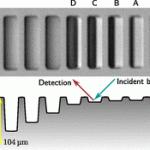
SM Lambrick; L Vozdeck`y; M Bergin; JE Halpin; DA MacLaren; PC Dastoor; SA Przyborski; AP Jardine; DJ Ward
Multiple scattering in scanning helium microscopy Journal Article
In: Applied Physics Letters, vol. 116, no. 6, pp. 061601, 2020.
@article{lambrick2020multiple,
title = {Multiple scattering in scanning helium microscopy},
author = {SM Lambrick and L Vozdeck{`y} and M Bergin and JE Halpin and DA MacLaren and PC Dastoor and SA Przyborski and AP Jardine and DJ Ward},
doi = {https://doi.org/10.1063/1.5143950},
year = {2020},
date = {2020-01-01},
urldate = {2020-01-01},
journal = {Applied Physics Letters},
volume = {116},
number = {6},
pages = {061601},
publisher = {AIP Publishing LLC},
abstract = {Using atom beams to image the surface of samples in real space is an emerging technique that delivers unique contrast from delicate samples. Here, we explore the contrast that arises from multiple scattering of helium atoms, a specific process that plays an important role in forming topographic contrast in scanning helium microscopy (SHeM) images. A test sample consisting of a series of trenches of varying depths was prepared by ion beam milling. SHeM images of shallow trenches (depth/width < 1) exhibited the established contrast associated with masking of the illuminating atom beam. The size of the masks was used to estimate the trench depths and showed good agreement with the known values. In contrast, deep trenches (depth/width > 1) exhibited an enhanced intensity. The scattered helium signal was modeled analytically and simulated numerically using Monte Carlo ray tracing. Both approaches gave excellent agreement with the experimental data and confirmed that the enhancement was due to localization of scattered helium atoms due to multiple scattering. The results were used to interpret SHeM images of a bio-technologically relevant sample with a deep porous structure, highlighting the relevance of multiple scattering in SHeM image interpretation.},
keywords = {},
pubstate = {published},
tppubtype = {article}
}
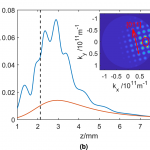
M Bergin; SM Lambrick; H Sleath; DJ Ward; John Ellis; AP Jardine
Observation of diffraction contrast in scanning helium microscopy Journal Article
In: Scientific reports, vol. 10, no. 1, pp. 1–8, 2020.
@article{bergin2020observation,
title = {Observation of diffraction contrast in scanning helium microscopy},
author = {M Bergin and SM Lambrick and H Sleath and DJ Ward and John Ellis and AP Jardine},
doi = {https://doi.org/10.1038/s41598-020-58704-1},
year = {2020},
date = {2020-01-01},
journal = {Scientific reports},
volume = {10},
number = {1},
pages = {1--8},
publisher = {Nature Publishing Group},
abstract = {Scanning helium microscopy is an emerging form of microscopy using thermal energy neutral helium atoms as the probe particle. The very low energy combined with lack of charge gives the technique great potential for studying delicate systems, and the possibility of several new forms of contrast. To date, neutral helium images have been dominated by topographic contrast, relating to the height and angle of the surface. Here we present data showing contrast resulting from specular reflection and diffraction of helium atoms from an atomic lattice of lithium fluoride. The signature for diffraction is evident by varying the scattering angle and observing sharp features in the scattered distribution. The data indicates the viability of the approach for imaging with diffraction contrast and suggests application to a wide variety of other locally crystalline materials.},
keywords = {},
pubstate = {published},
tppubtype = {article}
}
N Avidor; PSM Townsend; DJ Ward; AP Jardine; J Ellis; W Allison
PIGLE — Particles Interacting in Generalized Langevin Equation simulator Journal Article
In: Computer Physics Communications, vol. 242, pp. 145-152, 2019, ISSN: 0010-4655.
@article{nokey,
title = {PIGLE — Particles Interacting in Generalized Langevin Equation simulator},
author = {N Avidor and PSM Townsend and DJ Ward and AP Jardine and J Ellis and W Allison},
url = {https://www.sciencedirect.com/science/article/pii/S0010465519301274},
doi = {10.1016/j.cpc.2019.04.013},
issn = {0010-4655},
year = {2019},
date = {2019-09-01},
journal = {Computer Physics Communications},
volume = {242},
pages = {145-152},
abstract = {We present a package using Simulink and MATLAB to perform molecular dynamics simulations of interacting particles obeying a Generalized Langevin Equation. The package, which accounts for three spatial dimensions and rigid-body like rotation, is tuned to explore surface diffusion of co-adsorbed species. The physical parameters are species specific, and include user-defined colored noise spectra and memory friction kernels acting independently on translational and rotational degrees of freedom. We benchmark the simulations using established analytical results for dynamical correlation functions, and we use the package to numerically verify novel analytical results concerning dissipative rotational motion and multi-exponential friction kernels. The package provides a straight-forward way to expand the modeling of ultra-fast surface diffusion problems at the atomic scale.
Program summary
Program title: PIGLE — Particles Interacting in Generalized Langevin Equation simulator Program Files doi: http://dx.doi.org/10.17632/759j7vhfgp.1 Licensing provisions: GNU General Public License 3 Programming language: MATLAB/Simulink Nature of problem: Understanding molecular diffusion at surfaces is of fundamental and industrial interest, and requires bridging between the experiment and ab-initio theories. Molecular dynamics simulations are widely used to bridge the experimental and theoretical worlds, however normally surface dynamics simulations are done either under extreme simplifications (two dimensional Langevin with for single species adsorbate), or with all the substrate atoms as well as the adsorbate atoms included explicitly — at expensive computational cost. Solution method: We here present a simulator for generalized Langevin dynamics of co-adsorbed interacting species, accounting for surface diffusion in 3 spatial dimensions and rigid body rotation. The package allows also to perform statistical analysis of the computed trajectories, considering a configuration of scattering centers which is imposed on the translating and rotating center-of-mass.},
keywords = {},
pubstate = {published},
tppubtype = {article}
}
M Bergin; DJ Ward; J Ellis; AP Jardine
A method for constrained optimisation of the design of a scanning helium microscope Journal Article
In: Ultramicroscopy, pp. 112833, 2019, ISSN: 0304-3991.
@article{nokey,
title = {A method for constrained optimisation of the design of a scanning helium microscope},
author = {M Bergin and DJ Ward and J Ellis and AP Jardine},
url = {http://www.sciencedirect.com/science/article/pii/S0304399119300695},
doi = {10.1016/j.ultramic.2019.112833},
issn = {0304-3991},
year = {2019},
date = {2019-08-29},
journal = {Ultramicroscopy},
pages = {112833},
abstract = {We describe a method for obtaining the optimal design of a normal incidence Scanning Helium Microscope (SHeM). Scanning helium microscopy is a recently developed technique that uses low energy neutral helium atoms as a probe to image the surface of a sample without causing damage. After estimating the variation of source brightness with nozzle size and pressure, we perform a constrained optimisation to determine the optimal geometry of the instrument (i.e. the geometry that maximises intensity) for a given target resolution. For an instrument using a pinhole to form the helium microprobe, the source and atom optics are separable and Lagrange multipliers are used to obtain an analytic expression for the optimal parameters. For an instrument using a zone plate as the focal element, the whole optical system must be considered and a numerical approach has been applied. Unlike previous numerical methods for optimisation, our approach provides insight into the effect and significance of each instrumental parameter, enabling an intuitive understanding of effect of the SHeM geometry. We show that for an instrument with a working distance of 1 mm, a zone plate with a minimum feature size of 25 nm becomes the advantageous focussing element if the desired beam standard deviation is below about 300 nm.},
keywords = {},
pubstate = {published},
tppubtype = {article}
}
SM Lambrick; M Bergin; AP JArdine; DJ Ward
A ray tracing method for predicting contrast in neutral atom beam imaging Journal Article
In: Micron, vol. 113, pp. 61-68, 2018, ISSN: 0968-4328.
@article{nokey,
title = {A ray tracing method for predicting contrast in neutral atom beam imaging},
author = {SM Lambrick and M Bergin and AP JArdine and DJ Ward},
url = {https://www.sciencedirect.com/science/article/pii/S0968432818301380},
doi = {10.1016/j.micron.2018.06.014},
issn = {0968-4328},
year = {2018},
date = {2018-10-01},
journal = {Micron},
volume = {113},
pages = {61-68},
abstract = {A ray tracing method for predicting contrast in atom beam imaging is presented. Bespoke computational tools have been developed to simulate the classical trajectories of atoms through the key elements of an atom beam microscope, as described using a triangulated surface mesh, using a combination of MATLAB and C code. These tools enable simulated images to be constructed that are directly analogous to the experimental images formed in a real microscope. It is then possible to understand which mechanisms contribute to contrast in images, with only a small number of base assumptions about the physics of the instrument. In particular, a key benefit of ray tracing is that multiple scattering effects can be included, which cannot be incorporated easily in analytic integral models. The approach has been applied to model the sample environment of the Cambridge scanning helium microscope (SHeM), a recently developed neutral atom pinhole microscope. We describe two applications; (i) understanding contrast and shadowing in images; and (ii) investigation of changes in image formation with pinhole-to-sample working distance. More generally the method has a broad range of potential applications with similar instruments, including understanding imaging from different sample topographies, refinement of a particular microscope geometry to enhance specific forms of contrast, and relating scattered intensity distributions to experimental measurements.},
keywords = {},
pubstate = {published},
tppubtype = {article}
}
PSM Townsend; SJ Ward
The intermediate scattering function for quasi-elastic scattering in the presence of memory friction Journal Article
In: Journal of Physics Communications, vol. 2, iss. 7, pp. 075011, 2018, ISSN: 2399-6528.
@article{nokey,
title = {The intermediate scattering function for quasi-elastic scattering in the presence of memory friction},
author = {PSM Townsend and SJ Ward},
url = {https://dx.doi.org/10.1088/2399-6528/aad221},
doi = {10.1088/2399-6528/aad221},
issn = {2399-6528},
year = {2018},
date = {2018-07-23},
journal = {Journal of Physics Communications},
volume = {2},
issue = {7},
pages = {075011},
abstract = {We derive an analytical expression for the intermediate scattering function of a particle on a flat surface obeying the Generalised Langevin equation, with exponential memory friction. Numerical simulations based on an extended phase space method confirm the analytical results. The simulated trajectories provide qualitative insight into the effect that introducing a finite memory timescale has on the analytical line shapes. The relative amplitude of the long-time exponential tail of the line shape is suppressed, but its decay rate is unchanged, reflecting the fact that the cutoff frequency of the exponential kernel affects short-time correlations but not the diffusion coefficient which is defined in terms of a long-time limit. The exponential sensitivity of the relative amplitudes to the decay time of the chosen memory kernel is a very strong indicator for the prospect of inferring a friction kernel and the physical insights from experimentally measured intermediate scattering functions.},
keywords = {},
pubstate = {published},
tppubtype = {article}
}
JA Lau; I Calvo-Almazán; PSM Townsend; DJ Ward; AP Jardine; W Allison; BJ Hinch; N Avidor
Structural Evolution of a Cyclooctatetraene Adlayer on Cu(111) during Isothermal Desorption Journal Article
In: J. Phys. Chem. C, vol. 122, iss. 16, pp. 8941-8945, 2018, ISSN: 1932-7447.
@article{nokey,
title = {Structural Evolution of a Cyclooctatetraene Adlayer on Cu(111) during Isothermal Desorption},
author = {JA Lau and I Calvo-Almazán and PSM Townsend and DJ Ward and AP Jardine and W Allison and BJ Hinch and N Avidor},
url = {https://doi.org/10.1021/acs.jpcc.8b00482},
doi = {10.1021/acs.jpcc.8b00482},
issn = {1932-7447},
year = {2018},
date = {2018-04-03},
journal = {J. Phys. Chem. C},
volume = {122},
issue = {16},
pages = {8941-8945},
abstract = {The use of helium diffraction patterns to study desorption processes is explored as a novel extension to traditional methods based on helium specular reflection. The sample, cyclooctatetraene, adsorbed on Cu(111) provides a rich but complex structure. The modulation of cyclooctatetraene by Cu(111) is manifested as a convolution in the diffraction pattern, displaying an averaged super cell symmetry of . The adlayer expands during isothermal desorption, and the change in lattice constant provides a direct measure of the coverage as a function of time. We find a desorption energy of 0.96 ± 0.01 at saturation of the first layer and an upper limit of 1.62 ± 0.07 for isolated molecules. These values and details of the assigned structure indicate chemisorbed molecules with a planar conformation.},
keywords = {},
pubstate = {published},
tppubtype = {article}
}
A Tamtögl; B Davey; DJ Ward; AP Jardine; J Ellis; W Allison
Polarisation in spin-echo experiments: Multi-point and lock-in measurements Journal Article
In: Review of Scientific Instruments, vol. 89, iss. 2, 2018, ISSN: 0034-6748.
@article{nokey,
title = {Polarisation in spin-echo experiments: Multi-point and lock-in measurements},
author = {A Tamtögl and B Davey and DJ Ward and AP Jardine and J Ellis and W Allison},
url = {https://aip.scitation.org/doi/10.1063/1.5017276},
doi = {10.1063/1.5017276},
issn = {0034-6748},
year = {2018},
date = {2018-02-01},
urldate = {2018-02-01},
journal = {Review of Scientific Instruments},
volume = {89},
issue = {2},
abstract = {Spin-echo instruments are typically used to measure diffusive processes and the dynamics and motion in samples on ps and ns time scales. A key aspect of the spin-echo technique is to determine the polarisation of a particle beam. We present two methods for measuring the spin polarisation in spin-echo experiments. The current method in use is based on taking a number of discrete readings. The implementation of a new method involves continuously rotating the spin and measuring its polarisation after being scattered from the sample. A control system running on a microcontroller is used to perform the spin rotation and to calculate the polarisation of the scattered beam based on a lock-in amplifier. First experimental tests of the method on a helium spin-echo spectrometer show that it is clearly working and that it has advantages over the discrete approach, i.e., it can track changes of the beam properties throughout the experiment. Moreover, we show that real-time numerical simulations can perfectly describe a complex experiment and can be easily used to develop improved experimental methods prior to a first hardware implementation.},
keywords = {},
pubstate = {published},
tppubtype = {article}
}
